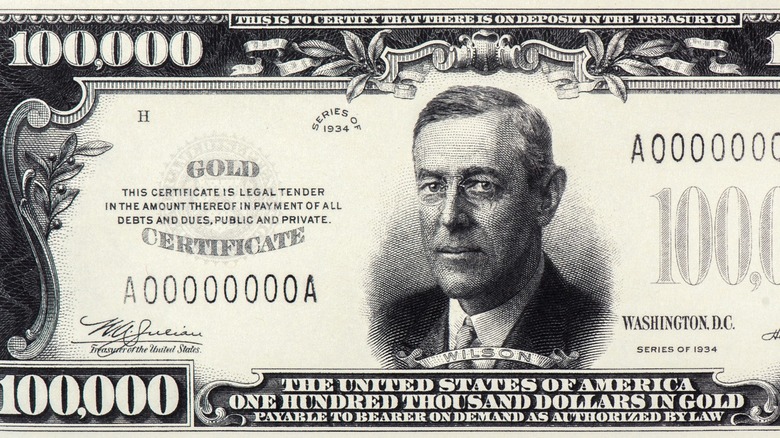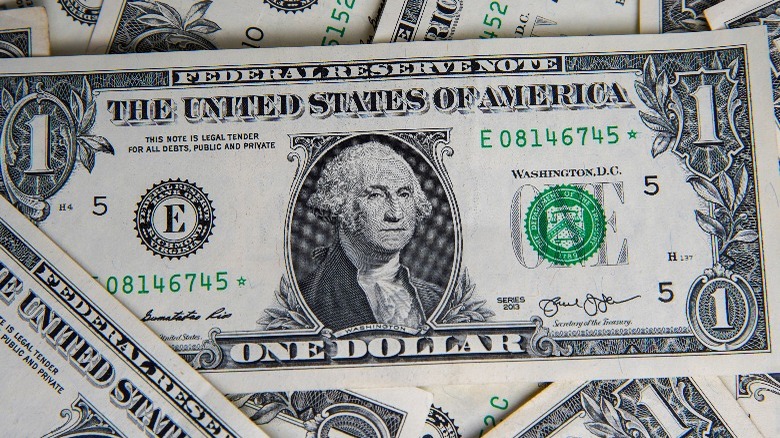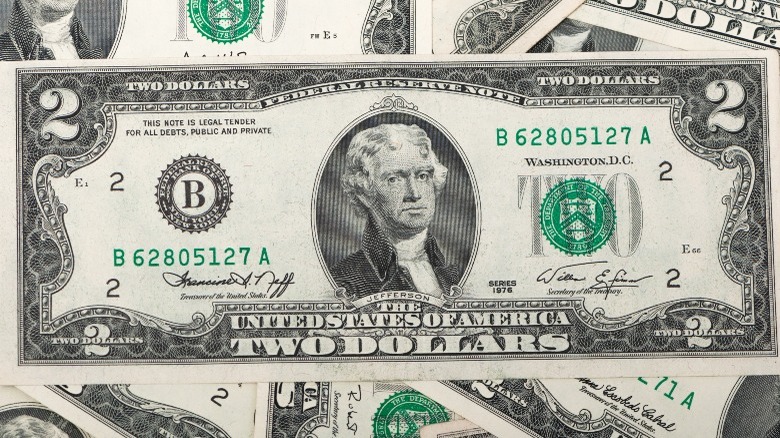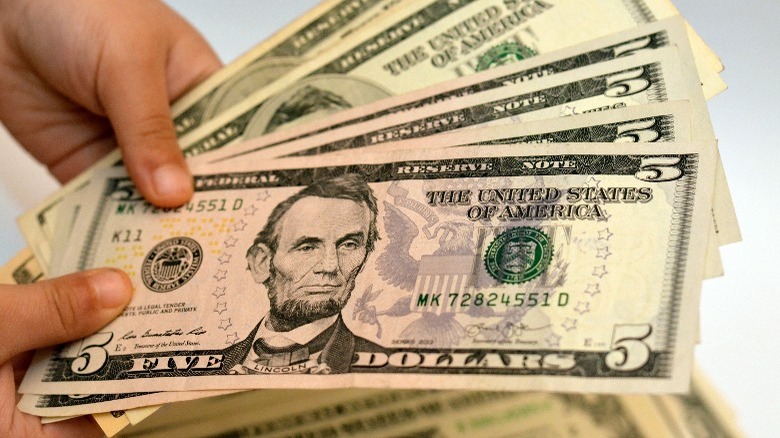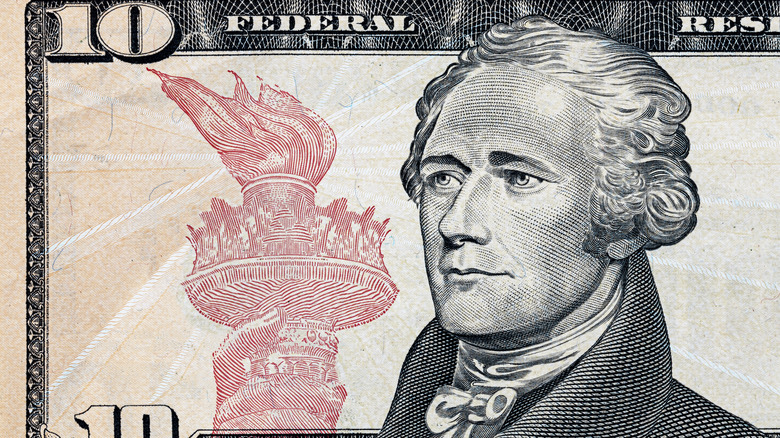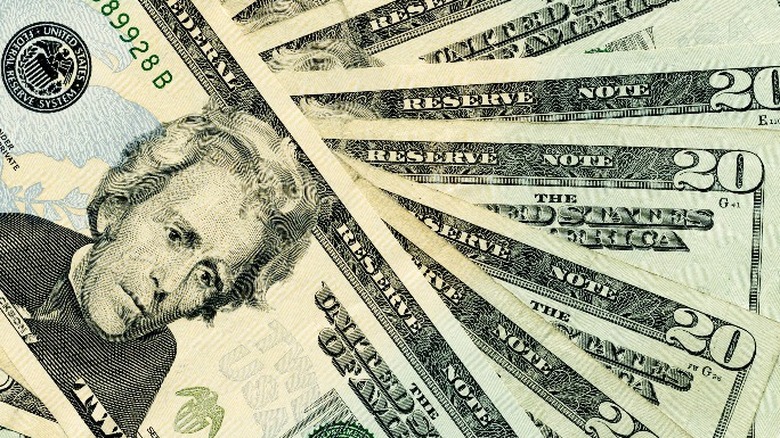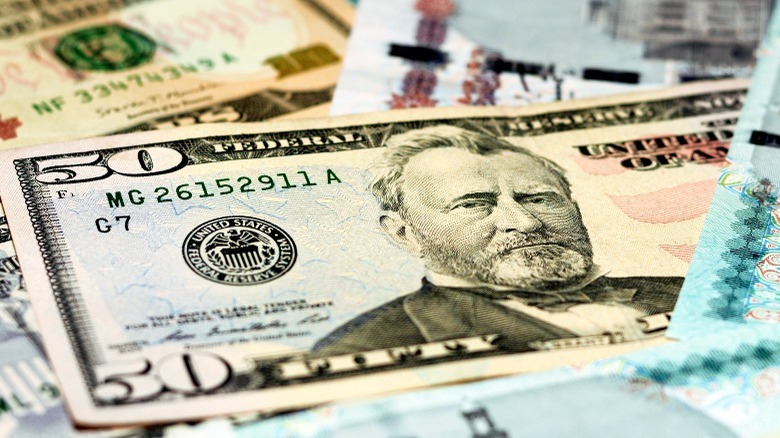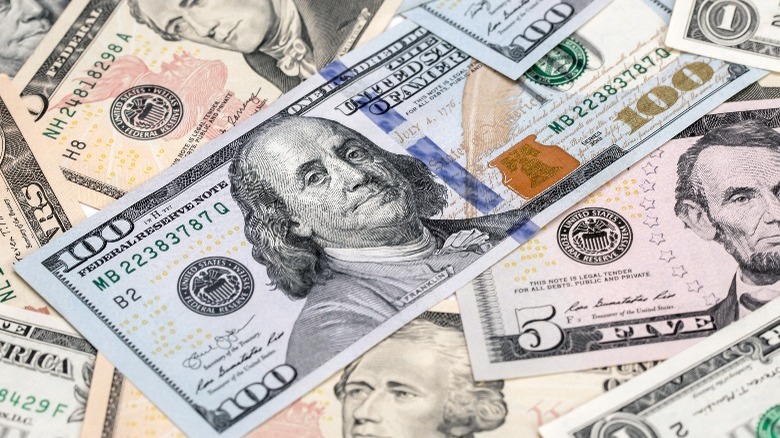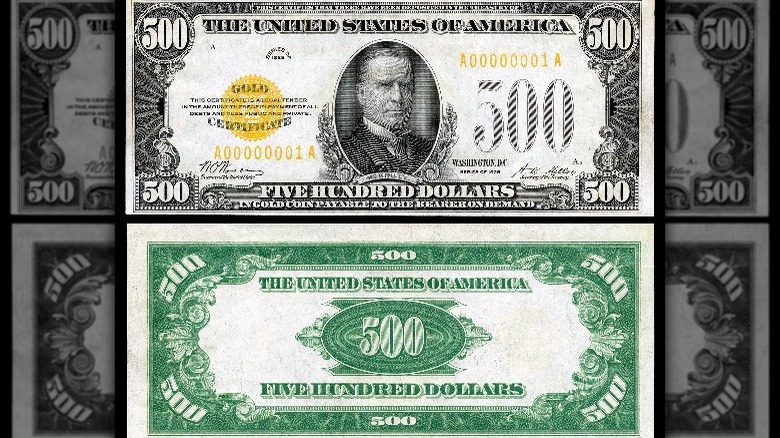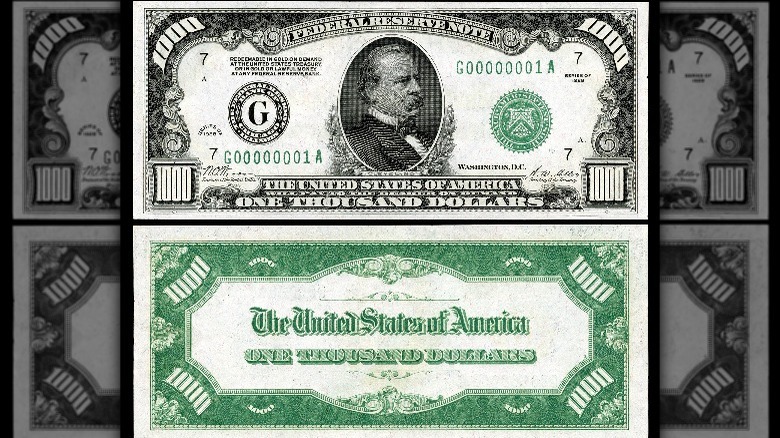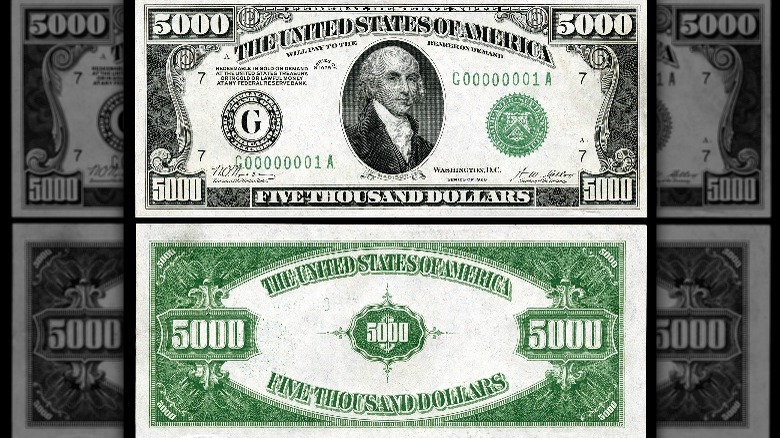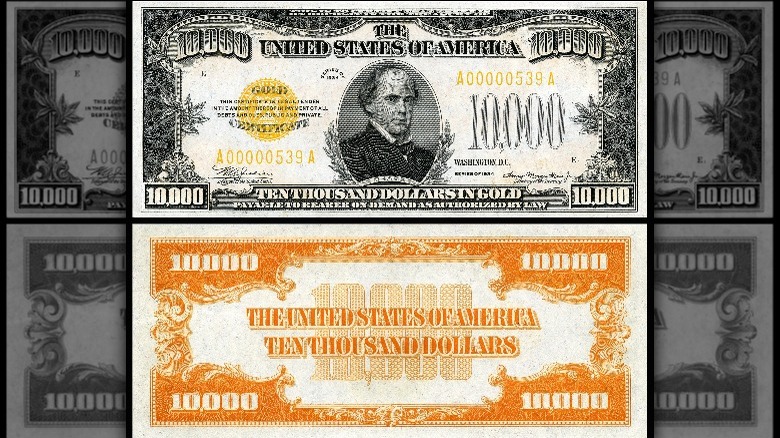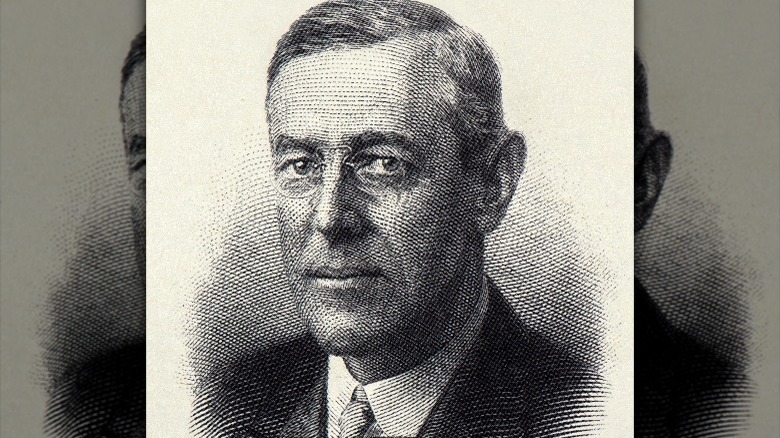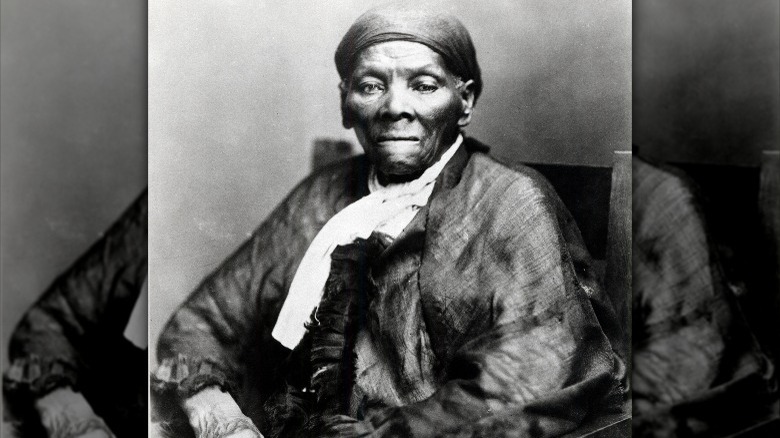Who Is On Every U.S. Bill?
Though it might sound strange, paper money has been a part of American history since before the United States was even conceived. The earliest official money in what would become the U.S. dates back to the late 17th century, when colonial governments first began issuing paper currency. Then in 1775, during the Revolutionary War, the Continental Congress issued Continental Currency nationally to help raise money.
It was not until 1861 that the more familiar green paper money, originally known as "greenbacks," came into vogue. The wartime Congress of the Civil War created them to finance the Union armies and government, and they were officially called Demand Notes. Congress replaced them in 1862 with Legal Tender notes. Traditionally, the government has put former presidents on currency — $10 Demand Notes issued in 1861 had President Abraham Lincoln's picture on them – but that's not always the case.
In 1913, Congress created the Federal Reserve and began issuing Federal Reserve notes, which became standardized in 1929. Currently, the Bureau of Engraving and Printing (BEP) prints seven different denominations of bills, ranging from $1 to $100, which are issued by the Federal Reserve Board. There were also four previous denominations, ranging from $500 to $10,000, that have not been in print since 1945, and even a $100,000 Gold Certificate that was last printed in 1935. From George Washington to Benjamin Franklin, here's who is on every U.S. bill.
George Washington: $1
Considering how well known George Washington is, it's little surprise that his picture is front and center on U.S. currency. As the first president in American history, few names hold the reverence and esteem that Washington does. Born in 1732 in what was then the colony of Virginia, Washington fought for the British in the French and Indian War (or the Seven Years' War in Europe) in the 1750s and 1760s. However, just a decade later he found himself fighting against the redcoats, as the commander in chief of the revolutionary forces in the Continental Army.
Washington was instrumental in America winning the Revolutionary War, and in 1789 the Founding Fathers unanimously elected him as the first U.S. president. Washington did not even need to campaign because he was so highly regarded, and he won a second term in 1792, also unanimously. In his time, Washington governed over an America that was merely a fraction of the size it is today, and the nation's capital is named in his honor.
Washington's face is synonymous with the $1 bill, and he has appeared on it since 1869. Likely due to its low value, the $1 bill is one of the least frequently counterfeited notes. The Federal Reserve most recently revised the bill in 1963, and it is the only bill that is prohibited by law (H.R. 5016) from being redesigned.
Thomas Jefferson: $2
Though you don't see them very often, the $2 bill actually has a pretty interesting backstory. They were among the first "greenbacks" the Treasury printed in 1862 during the Civil War, and have featured Thomas Jefferson's face since 1869. Yet, according to the CNB St. Louis bank, $2 bills have long been regarded as evil or associated with nefarious activities. The government started issuing them to soldiers as part of their pay during the Second World War, partly as a way to get rid of the huge stockpiles of them. The Department of the Treasury stopped printing the $2 bill from 1966 to 1976, and currently only prints them periodically.
It's easy to see why Jefferson's face is on the $2 bill, as he is one of the most respected names in American history, alongside the other Founding Fathers. Americans widely know him as the "Father of the Declaration of Independence" and for the Louisiana Purchase. He was a strong proponent of religious liberty, and served terms as both the Virginia governor and U.S. minister to France. He became the third American president in 1801, and he won reelection in 1804. He died in 1826, and he is one of the four faces on Mount Rushmore.
Abraham Lincoln: $5
Often called by his sobriquet "Honest Abe," Abraham Lincoln was a virtual shoo-in to be on currency. Lincoln entered politics in 1846 as a U.S. representative from Illinois, but failed to win election as a senator in 1856. Instead, four years later he ran for the presidency and won, which helped set off the Civil War due to his party's rhetoric on slavery.
Presiding over the country during one of its most tumultuous times, Lincoln was able to save the Union from complete collapse and help vanquish the Confederacy. His administration also presided over the original introduction of the "greenbacks" in 1861. There were extremely high expectations for his second term, but John Wilkes Booth murdered Lincoln on April 14, 1865, just days after the war had ended. Today, the revered president's name is synonymous with the outlawing of slavery in America, and he is one of the most celebrated American figures in history.
Lincoln's first appearance on U.S. currency came on the original $10 Demand Notes of 1861. In 1869, he appeared on the $100 bill, and beginning in 1914 his image was used on the $5 bill. Since then, the bill has undergone major revisions in 1929, 1993, 2000, and 2008. The 1914-series $5 bill had vignettes of Christopher Columbus and the Pilgrims on the back, but since 1929 the back has featured the Lincoln Memorial.
Alexander Hamilton: $10
It seems like Alexander Hamilton has pretty much been on U.S. currency since the Department of the Treasury first began releasing greenbacks in 1861. During the original series of Demand Notes issued that year, Hamilton's face appeared on the $5 bill, and the Treasury used his likeness on the $2 Legal Tender notes they issued the following year. In 1878, they put him on the $20 note, and in 1882 he appeared on the $1,000 Gold Certificates that used orange backs and could be redeemed for gold coin. Each of these notes featured a different picture of Hamilton.
From 1918 to 1928, Hamilton's portrait adorned the $1,000 bill from the Federal Reserve. However, in 1929 the Treasury swapped Hamilton onto the new $10 bill, where he has remained ever since. Hamilton is one of just two non-presidents to currently grace the face of an American bill, and the back of the bill features the U.S. Treasury Building.
Even though he was never a president, Hamilton still had an outsized impact on the founding of America. He was a veteran of the Revolutionary War, a Founding Father, a noted Federalist, and served as the first secretary of the U.S. Treasury. Hamilton died in 1804 after being shot in a duel with Aaron Burr.
Andrew Jackson: $20
Now regarded by many as one of the most controversial presidents of American history, Andrew Jackson has appeared on U.S. currency dating back to the $5 bill in 1869. From 1914 to 1928, his face appeared on the $10 bill, and in 1929 the Treasury removed Jackson from the $10 bill and instead put him on the $20 bill, where he still resides today.
Yet, while Jackson is currently the face of the $20 bill, that will change in 2030. This is due to Obama administration Treasury secretary Jacob J. Lew, who decided to replace Jackson with abolitionist and civil rights figure Harriet Tubman. In recent decades, Jackson's image on the $20 bill had become a source of controversy, due to some of his racist policies which resulted in the Trail of Tears, as well as because of his dedication to the institution of slavery.
Since the Treasury first issued them with Jackson's likeness in 1929, the $20 bill has gone through three different revisions, in 1990, 1998, and 2003. From 1929 to 1998, the note used the same portrait, but starting in 1998 it began using a close-up version, which it still uses today.
Ulysses S. Grant: $50
Appearing on the $50 bill since 1914, Ulysses S. Grant is one of the few former presidents who is more well known for his exploits from before he was elected to office. Grant first joined the Union Army in 1843, and he served during the Mexican-American War. However, he left the Army in 1854 and began working a series of civilian jobs to feed his family. Yet, Grant returned to the military fold in 1861 just as the Civil War was breaking out. Remaining loyal to the Union, Grant served with distinction for several years, finally becoming the commander of all Union armies in 1864.
Grant accepted Confederate General Robert E. Lee's surrender to end the war, and in 1868 he entered politics for the first time, winning the presidency by a significant electoral college margin. Grant served for two terms as president, winning an even higher margin of electoral college votes in 1872. Unfortunately, Grant's cabinet was beset by corruption and various scandals, and he died in 1885, a few years after leaving office.
The Treasury put Grant on the $50 bill in 1914, and he is still on there today. The $50 note has gone through several revisions in 1929, 1990, 1997, and 2004. In 2010, Republican Rep. Patrick McHenry suggested removing Grant from the $50 in favor of Ronald Reagan, but those efforts did not amount to anything.
Benjamin Franklin: $100
Along with Alexander Hamilton, former statesman Benjamin Franklin is one of only two non-presidents to have his image currently being used on U.S. currency. In 1874, Franklin first appeared on the $50 bill, and he was later on the $10 bill. He has appeared on the $100 bill since 1914, which is currently the largest of the seven U.S. currency denominations in active circulation.
From 1914 to 1928, the Federal Reserve used a side profile of Franklin for the bill, but beginning in 1929 that changed to a more traditional front portrait. In 1996, the reserve began using another image of Franklin, which it still uses today. Until 1928, the back of the $100 bill had a vignette consisting of several figures depicting the principles of Labor, Plenty, America, Peace, and Commerce, which changed to Independence Hall in 1929.
Despite never becoming president, Franklin's fingerprints are all over the founding of the United States. He was an inventor and printer, and in 1775 the Continental Congress named him the country's first postmaster general. He helped draft the Declaration of Independence, and served for much of the Revolutionary War as the American minister to France. He was a paramount figure in both the ending of the war and the ratification of the Constitution, and he is one of the most beloved people in American history.
William McKinley and John Marshall: $500
With their births separated by nearly 100 years, there is not a lot John Marshall and William McKinley have in common, except that they both appeared on the $500 bill while it was still in print. Marshall, born in 1755, was a veteran of the Revolutionary War, a prominent Federalist, and a former member of the House of Representatives from Virginia. In 1800, he briefly served as secretary of state before becoming an influential chief justice on the Supreme Court from 1801 to 1835.
In contrast, McKinley was born in 1843, served in the Civil War, and was also briefly a House of Representatives member, but for Ohio. He was elected to the presidency in 1896, and won reelection in 1900. He presided over the country during the Spanish-American War, which ended with the U.S. gaining the territories of Puerto Rico, Guam, and the Philippines. Just after winning reelection, McKinley was shot during an assassination attempt, and he died from his wounds a week later.
McKinley first appeared on currency in 1902 on the $10 National Bank notes. From 1918 to 1927, Marshall's portrait graced the $500 bill, and from 1928 to 1969 the Treasury replaced him with McKinley. The Treasury has not issued the $500 bill since 1969, and it has been out of print since 1945.
Grover Cleveland: $1,000
Grover Cleveland might not have the name recognition of George Washington or Abraham Lincoln, but he was still a very important president and figure during his time. Cleveland has the distinction of being both the 22nd and 24th U.S. president, winning elections in 1884 and 1892. In between, Benjamin Harrison defeated him in 1888, and Cleveland left the White House to work as a lawyer. His party urged him to run for a third term in both 1896 and 1904, as presidents were still legally allowed unlimited terms, but he decided not to and instead worked as a trustee at Princeton University. Owing to his popularity relative to his party-mates, Cleveland was the only Democrat to win the presidency from the outbreak of the Civil War until almost the start of World War I.
Cleveland died of a heart attack on June 24, 1908, and just six years later he found himself on the $20 bill. In 1928, he was moved to the $1,000 bill. Like other high-denomination U.S. currency, the $1,000 bill has been out of print since 1945, and the Treasury has not issued it since 1969.
James Madison: $5,000
It might seem unfathomable to some people, but at one point the U.S. actually had a $5,000 bill. The Department of the Treasury first introduced it in 1878, and it featured the face of former President James Madison. In 1918, the Federal Reserve issued its first $5,000 notes with Madison still as the face, which have been out of print since 1945. Madison was the only president ever featured on the bill, and the back actually featured John Trumbull's painting of George Washington Resigning his Commission to the Continental Congress — of which Madison was a part.
If Thomas Jefferson is considered the "Father of the Declaration of Independence," then Madison must be considered the "Father of the Constitution." Madison played a large role in getting the Constitution to succeed the Articles of Confederation, which he felt had too weak of a central government. He also helped to draft the Bill of Rights, and was a member of the first U.S. Congress. After serving as secretary of state for two terms under Jefferson and helping to acquire the Louisiana Purchase, Madison served for two terms as president from 1809 to 1817. He died in 1836 from natural causes.
Salmon P. Chase: $10,000
Admit it: You probably did not realize that a $10,000 bill had even existed at one point. Apparently, they date all the way back to 1878, when the Department of the Treasury issued the first $10,000 Legal Tender notes with President Andrew Jackson on them. Like other higher-denomination currencies, the $10,000 bill has been out of print since 1945 and out of circulation since 1969. From 1918 to 1969, Salmon P. Chase appeared on the $10,000 bill, the back of which originally featured a vignette commemorating the Pilgrims.
During his career, Chase was an incredibly influential American, playing a key part in Abraham Lincoln's cabinet during the Civil War and serving as chief justice on the Supreme Court for nearly a decade. On the court, he presided over several landmark cases, including the impeachment of Andrew Johnson and Reconstruction cases. Chase first appeared on lower-denomination currency, gracing the $1 Legal Tender notes of 1862 and later finding himself on the $10 bill in 1863 and 1864. The $10,000 bill is the highest denomination of American currency ever circulated among the general public.
Woodrow Wilson: $100,000 Gold Certificate
It might seem as mythical as Mr. Burns and his $1 trillion bill, but the $100,000 note of currency actually existed. The Department of the Treasury printed the $100,000 Gold Certificate for just a few weeks during the transition from 1934 to 1935, and they featured the face of former President Woodrow Wilson. The notes were not actually available for individuals to use, as the Treasury never circulated them among the general public. The only use of them was by Federal Reserve Banks, which circulated them between one another during official transactions.
The $100,000 Gold Certificate is the largest denomination of currency the Department of the Treasury has ever released. The choice for Wilson was not obvious, but also not controversial. Wilson served as president from 1913 to 1921, guiding America through the First World War, establishing the Federal Reserve, and helping to create the League of Nations. He also oversaw the introduction of Prohibition, as well as women's suffrage, during his time in office. Wilson died in 1924, and the $100,000 note is the only denomination he has appeared on.
Harriet Tubman: $20
As of 2023, Andrew Jackson was still the face of the $20 bill, but that will be changing by 2030. Due to Jackson's controversial tenure as president, in 2016 the Obama administration made the decision to replace him with abolitionist and civil rights icon Harriet Tubman. Jackson will still appear on the bill on the back, but Tubman's image will be front and center. Tubman will be the first person of color and the first woman to appear on the front of a currently issued denomination of currency. (Martha Washington appeared on $1 Silver Certificates issued by the Treasury department in 1886 and 1891.) The Trump administration briefly halted progress on the new $20 bill, but it started again under the Biden administration.
Tubman was chosen due to her extensive antislavery efforts, which included being a conductor on the Underground Railroad and serving as a Union spy and nurse during the Civil War. As of 2016, there were also plans to include several other groundbreaking women and people of color on U.S. currency in the future. These include Susan B. Anthony, Elizabeth Cady Stanton, Lucretia Mott, Alice Paul, Sojourner Truth, Marian Anderson, Eleanor Roosevelt, and Martin Luther King Jr.
